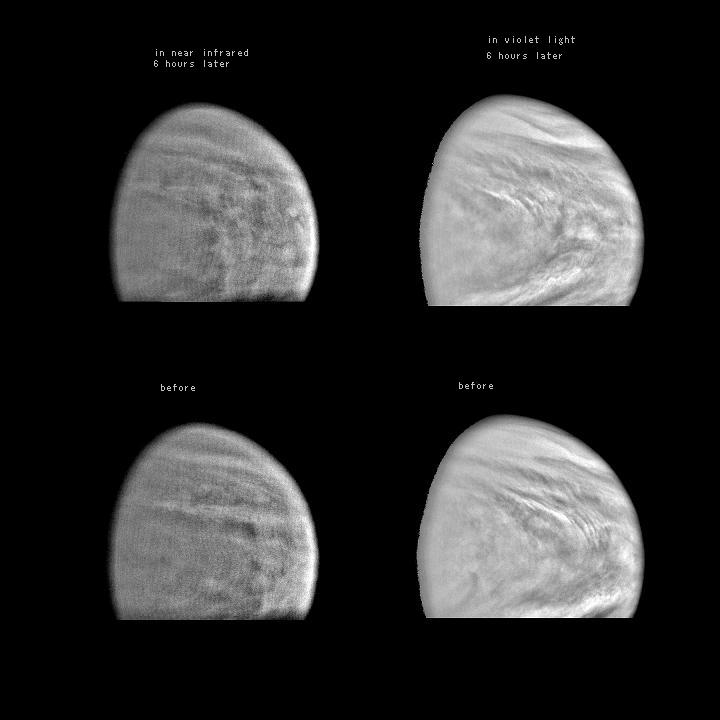
Original 1800 X 1800 1057kB tif
These images of the Venus clouds were taken by Galileo's Solid State Imaging System February 13,1990,
at a range of about1 million miles.
The smallest detail visible is about 20 miles. The two right images show Venus in violet light,
the top one at a time six hours later than the bottom one. They show the state of the clouds near the
top of Venus's cloud deck. A right to left motion of the cloud features is evident and is consistent
with westward winds of about 230 mph.
The two left images show Venus in near infrared light, at the same times as the two right images.
Sunlight penetrates through the clouds more deeply at the near infrared wavelengths, allowing a view
near the bottom of the cloud deck. The westward motion of the clouds is slower (about 150 mph) at the
lower altitude. The clouds are composed of sulfuric acid droplets and occupy a range of altitudes from
30 to 45 miles. The images have been spatially filtered to bring out small scale details and de-emphasize
global shading.
The filtering has introduced artifacts (wiggly lines running north/south) that are faintly visible in
the infrared image.
The Galileo Project is managed for NASA's Office of Space Science and Applications by the Jet Propulsion
Laboratory; its mission is to study Jupiter and its satellites and magnetosphere after multiple gravity
assist flybys at Venus and Earth.
Japanese
ガリレオにより1990/02/13に撮影された。
右が紫外線 左が赤外線である。左右は同時刻で、上下の画像は6時間差で撮影されました。
解像力は34kmです。
右側の紫外線画像は雲の頂上を映し出しています。
右から左への雲の動きが明瞭に捉えられており、時速約390kmの西向の風と一致しています。
左側赤外線画像ではもう少し雲の低い高度が写しだされています。(時速約250kmの西向)
雲は、硫酸小滴でできており、50 〜 75 kmの高度の範囲にあります。
小規模詳細構造を見やすくするため全体的な画像処理をしてあります。
赤外画像における南北の細い縞は画像処理やフィルターの影響による人工的なものです。
[NASA/JPL/Space Science Institute]
|

 ALPO-Japan Latest
ALPO-Japan Latest

 Venus Section
Venus Section